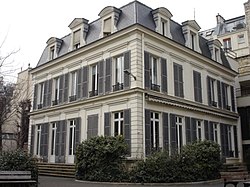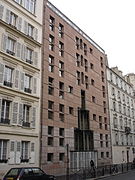École alsacienne
| École alsacienne | |
|---|---|
 | |
| Location | |
 | |
109, rue Notre-Dame-des-Champs, Paris | |
| Coordinates | 48°50′28″N 2°20′02″E / 48.841111°N 2.333889°E |
| Information | |
| Type | Private school |
| Motto | Ad nova tendere sueta (Towards novelty from tradition)[1] |
| Established | 1874 |
| Principal | Pierre de Panafieu |
| Website | https://www.ecole-alsacienne.org/ |
The École alsacienne is a co-educational private school located in the 6th arrondissement of Paris.[2][3][4]
The school was founded by a group of French Alsatians after the French defeat in the Franco-Prussian War. It then became a model for reforming the school system under the Third Republic,[5] and is still to this day a leading establishment of the French secondary education system.
History[edit]
The school was officially founded in 1874,[5] after three years of functioning, by teachers and Protestant academics from Alsace[6] who came to France after the annexation of Alsace-Lorraine by the German Empire during the Franco-Prussian War.
The new school was an establishment for secondary education[6] based on the model of the Jean Sturm Gymnasium, with the ambition of "producing a type of man who was cultivated, and combines the virtues of the regional soul with the general qualities of the humanist".[6] The two first headmasters of the school, Frédéric Rieder (from 1874 to 1891) and Théodore Beck (from 1891 to 1922), were both pastors and former students of the Jean-Sturm Gymnasium.
Later, the school was headed by Henri Péquignat (1922-1936), Jacques Vallette (1936-1945), Jean Neel (1945-1953), Georges Hacquard (1953-1986), Jean-Pierre Hammel (1986-1988), René Fuchs (1988-2001), Pierre de Panafieu (since 2001).
The school rapidly became one of the testing grounds for public education, known as a "pilot school".[5] Non-religious since 1874, mixed in 1908,[7] it insisted from its inception on the importance of French (rather than Latin) and foreign languages. It opened a gymnasium and science labs in 1881. Audiovisual methods of teaching were introduced in 1963, with the introduction of CCTV.
Running from kindergarten to the final year, the École alsacienne is one of the most reputable schools in Paris. Students from the École alsacienne often come from amongst the most privileged sectors of society, due to their selection and admission policies, and its geographic location.[8] However, thanks to its scholarship system and due to the limited price of admission, it has maintained a relative social diversity, with strong attendance from the middle class. The establishment offers relatively few integrated places, as many students stay there throughout their school life.[6] The admissions are mainly made in 6th Form (beginning of middle school), as more than half of the student body is admitted at this time. The school considered opening an establishment in Argenteuil,[6] but the project never took place, due to lack of public investment.[8]
Teaching[edit]
General[edit]
The school uses active methods of teaching. Therefore, the child's development is placed at the heart of the educational system, including in the layout of the spaces.[6] Teaching of sport, plastic arts, and music is central, including in the creation of a classe à horaires aménagés musique in the college.
In order to empower students and their families, the school practices education without punishment or reward.
Languages take an important role in the education. German is taught in the first years in the school, but Chinese has been taught since 1963. English courses are obligatory from the beginning of elementary school, and leads to intensive language courses in college and lycée, particularly in the European (specifically English) and Oriental (particularly Chinese) sections.
Since the 2000s, the Ecole alsacienne has offered exchange programs with some partner schools which includes Beijing Jingshan School, Sydney Grammar School, Theresianum Akademie, Daly College, St. Paul's School (New Hampshire), Maru A Pula School, Hotchkiss School, The Dalton School, Lakefield College School, Ashbury College.[9][10]
Cost[edit]
As the establishment is a private school, education is paid for 912 euros per trimester; there are also scholarships. Entrance is selective: in 2014, there were 300 applications for entry to the 6th Form, for 60 places.[8]
Languages studied[edit]
- German (LV1 until 6th form)
- English (from primary, LV1 until 6th form with a class reserved for bilingual students by level, European section from the 4th year.)
- Chinese (LV2 until 6th form, LV3 from second, Oriental section from the 4th year)
- Spanish (LV2 from the 5th year, LV3 from the second)
- Ancient Greek (option from the second)
- Italian (LV2 from the 5th year)
- Latin (obligatory from the 5th year, optional from the 4th)
- Russian (LV3 from the 4th year)
Lycée ranking[edit]
In 2015, the lycée was ranked 12th of 109 at departmental level in terms of teaching quality, and 130th at national level.[11] The ranking was based on three criteria: baccalauréat results, the proportion of students who obtain their baccalauréat having studied at the school for their last two years, and "added value" (calculated based on the social origin of students, their age, and their diploma results).[12] The Ecole alsacienne is ranked 7th in Paris, and 11th nationwide for 2020.[13]
Location[edit]
The school is found at 109, rue Notre-Dame-des-Champs in Paris, in the 6th arrondissement of Paris (between the Petit Collège and the Premières/Terminales at 128, rue d’Assas), not far from the Port-Royal and the Jardin du Luxembourg.
Notable former pupils[edit]
A[edit]
- Paul Ackerman
- Catherine Allégret
- Jean Claude Ameisen
- Gabriel Attal
- Axel Auriant
- Jean-Christophe Averty
B[edit]
- Élisabeth Badinter
- Édouard Baer
- Nathalie Baye
- Pierre Bellemare
- Jean-Paul Belmondo
- Pervenche Berès
- Nicolas Berggruen
- Olivier Berggruen
- Adrien Bertrand
- Raphaële Billetdoux
- Nino Boccara
- Marc Boegner
- Jean de Boishue
- Alain Bombard
- Michel Boujenah
- Emmanuel Bove
- Jean Brachet
- Juan Branco
- Thierry Breton
- Jean de Brunhoff
- Denis Buican
- Michel Butel
- Agnès Buzyn
C[edit]
D[edit]
E[edit]
F[edit]
G[edit]
H[edit]
I[edit]
J[edit]
K[edit]
L[edit]
M[edit]
- Horace Mallet
- Elli Medeiros
- Marc Minkowski
- Henry de Monfreid
- Antoine Monis
- Jérôme Monod
- Théodore Monod
- Vincent Moscato
P[edit]
- Jean-Jacques Pauvert
- Gilles Pélisson
- Guillaume Pepy
- Francis Perrin
- Michel Piccoli
- Frédéric Pottecher
R[edit]
S[edit]
- Arthur Sadoun
- Léa Salamé
- Claude Sarraute
- Joël Schmidt
- Colombe Schneck
- Georges Scott
- Michel Seydoux
- Benjamin Siksou
- Sacha Sperling
V[edit]
W[edit]
Z[edit]
Gallery[edit]
- École
-
Building 1 and the courtyard of the 6th and 5th
-
The Auburtin building
-
View of the school from the terrace of 128, rue d'Assas
-
Stairs from the basement of Philippe Bosseau
-
Auburtin building, next to the IT lab
-
Sports court
-
« La Maison blanche » of 107, rue Notre-Dame-des-Champs, bought in 1973 : used as a headmaster's office.
-
Entrance of 109, rue Notre-Dame-des-Champs
-
Entrance of 107 bis, rue Notre-Dame-des-Champs
-
Entrance of 107, rue Notre-Dame-des-Champs
-
Entrance of 128, rue d'Assas
Bibliography[edit]
- Jacques Allier, « Les origines de l’École alsacienne », Bulletin de la Société de l'histoire du protestantisme, vol. 121, 1975, p. 100-112. JSTOR 24294800.
- Sylvia Avrand-Margot, « Musique à l'école : éducation musicale à l'école alsacienne (Paris) », in La Lettre du musicien, 1998, 208
- Théodore Beck, Mes souvenirs 1890-1922, Paris, Fischbacher, 1934, 220 p.
- Cinquantenaire de l'École alsacienne, Paris, s.d. (1924), 258 p.
- École alsacienne : Paris : inauguration des nouveaux bâtiments : discours (9 juin 1881), Cerf, Paris, 1881, 27 p.
- « L'École alsacienne », les Saisons d'Alsace, 1994
- Georges Hacquard, Histoire d'une institution française : l'École alsacienne,
- tome 1 : « Naissance d'une école libre 1871-1891 », Paris, Garnier, 1982, 356 p.
- tome 2 : « L'école de la légende 1891-1922 », preface by Jean Bruller, Paris, Suger, 1987, 528 p.
- tome 3 : « La tradition à l'épreuve 1922-1953 », 352 p.
- tome 4 : « L'école du contrat 1953-1986 », 378 p.
- Gabriel Monod, Les réformes de l'enseignement secondaire et l'École alsacienne, Paris, 1886
- Maurice Testard, Une belle école. Histoire anecdotique préfilmée de l'École alsacienne, préface by Vercors, Paris, Vigot frères, 1950, 121 p.
Notes and reference[edit]
- ^ site des anciens élèves de l'école.
- ^ Figaro, Madame (2018-12-09). "Maternelles (très) privées : le meilleur à tout prix". Madame Figaro. Retrieved 2020-04-05.
- ^ Ltd, Macmillan Education (2015-12-22). Contemporary French Society. Macmillan International Higher Education. ISBN 978-1-349-86105-7.
- ^ Frustration, Revue. "Comment l'élite fait le choix de l'inégalité des chances à l'école". Club de Mediapart (in French). Retrieved 2020-04-05.
- ^ a b c "L'histoire de L'École alsacienne par Roger Gruner". ecole-alsacienne.org. 7 May 2004 [modified on 20 November 2009]. Retrieved 17 March 2018..
- ^ a b c d e f Natacha Polony, « École alsacienne : les raisons d'un succès », Le Figaro, 21 June 2010, p. 2.
- ^ The history of the education of women in France meant that mixed education was not generally used in the French education system until the 1960s.
- ^ a b c Colombe Schneck, « École alsacienne, les liens du rang », GQ, September 2015, pages 94-98.
- ^ Parent, Brice; Ellinger, Morgane (2019-08-20). "Présentation des échanges linguistiques et culturels". École alsacienne (in French). Retrieved 2020-04-05.
- ^ "DGI Language Exchange Trip to Paris - 2012". Dalton School. 2012-04-15. Retrieved 2020-04-05.
- ^ Classement départemental et national du lycée
- ^ Méthodologie du classement national des lycées français
- ^ "Classement des lycées 2020 : Lycée L'Ecole alsacienne à Paris". www.linternaute.com (Figaro Group) (in French). Archived from the original on 2018-04-01. Retrieved 2020-04-05.
See also[edit]
- Jean Sturm Gymnasium, private Protestant school in Strasbourg











